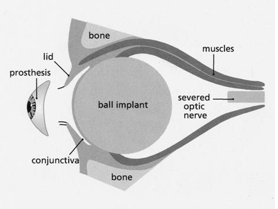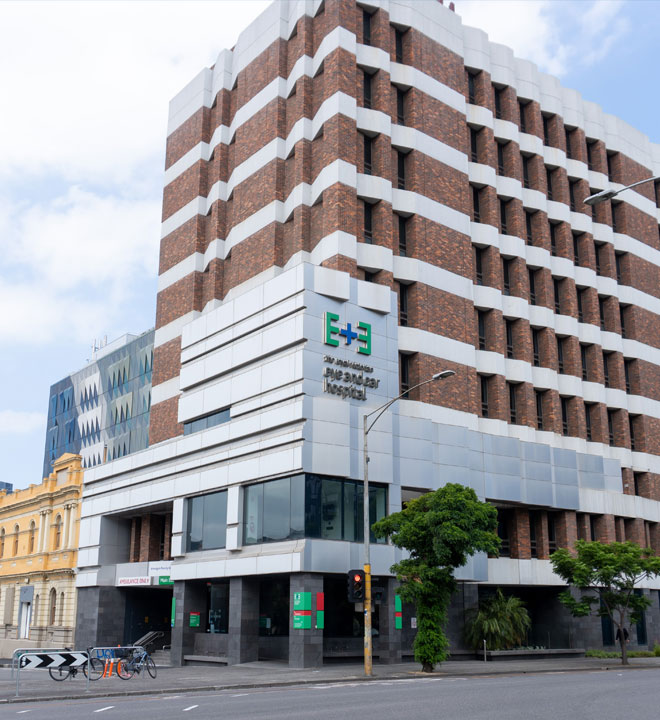What is enucleation and evisceration?
Enucleation and evisceration are terms that refer to surgery to remove the eye from the eye socket or orbit.
- Enucleation is the surgical removal of the entire eyeball leaving behind the lining of the eyelids and muscles of the eye.
- Evisceration removes only the contents of the eye, leaving the white part of the eye (the sclera) and the eye muscles intact.

Image courtesy of University Hospital Coventry, United Kingdom.
Why is enucleation or evisceration necessary?
Removal of an eye may be required following a severe injury, to remove intra-ocular tumours (tumours inside the eye), to control pain in a blind eye, to alleviate a severe infection inside the eye, or for cosmetic improvement of a disfigured eye.
What are the risks of having surgery?
There is a small risk that the ball implant will become exposed and infected. This would require further surgery. There can be some drooping of the upper eyelid. The lower lid may sag from the weight of the artificial eye and this may require corrective surgery.
Are there any alternative treatments available?
There may be other treatments available and your doctor will have discussed these with you. If you feel that you need further information please ask your doctor or specialist nurse.
What will happen if I choose not to have surgery?
There can be a number of different outcomes if you choose not to have your eye removed. An intraocular tumour may continue to grow or spread to other parts of the body making treatment more difficult. An infected eye may become worse and the infection may spread making treatment and pain management more difficult.
Why choose one procedure over another?
Enucleation is generally the procedure used if the eye is being removed to treat an intraocular tumour, severe infection or to reduce the risk of developing a severe autoimmune condition called sympathetic ophthalmia following trauma to the eye.
Evisceration is a less invasive procedure and may be an option depending on the condition of the eye to be operated on. Your surgeon will advise which surgery is most appropriate for you.
How is the surgery performed?
- Both surgeries are performed in the operating room and usually under general anaesthetic, but can also be safely performed using local anaesthetic with sedation.
- There can be some side effects with both local and general anaesthetic including nausea and confusion.
- A marble size ball implant is placed behind conjunctiva tissue in your socket to replace lost tissue volume when your eye is removed.
- In some cases, the implant is wrapped in sclera (the outer white coat of a donor eye) before being placed into the socket.
- There are different types of implants used including glass, plastic, silicone and porous implants such as Medpor (porous polyethylene), hydroxyapatite or bioceramic.
- There are advantages and disadvantages to each type of implant and your doctor will discuss these with you.
- The implant may be connected to the eye muscles to enable movement of the implant and the artificial eye when it is later fitted.
- A conformer (thin plastic shell) may be placed in the eye socket at the end of the operation to help maintain the shape of the socket and reduce swelling.
- During the operation, you will be given an injection of local anaesthetic. This is usually effective in relieving pain for several hours after your operation. After this, any pain is usually well controlled by painkillers which your nurse will organise.
- The operation takes about one to two hours.
- A pressure bandage is often put on to help with swelling.
- Once healed, your eye socket will look similar to the skin on the inside of your lip. Your tear function will not be affected, and when you have your artificial eye fitted, you will be able to open and close your eyelids as normal.
Preadmission and Day of the surgery
Before your surgery you will have a pre-admission assessment, by phone or at a clinic appointment, where a nurse or anaesthetist will talk through your surgery with you. Your surgery will be at The Royal Victorian Eye and Ear Hospital, 32 Gisborne Street, East Melbourne, phone: (03) 9929 8666.
On the day of surgery please bring with you:
- Medicare Card and Private Health insurance card if you have one
- Any medications you are taking in their original box
- Personal items you may need such as toiletries.
It is a good idea to have someone stay with you while you wait to go to theatre.
After the surgery?
- You will wake up in the recovery room and have a pressure bandage or pad over your operated eye. After you wake up you will be taken to the ward
- Most patients stay in hospital for one or two days.
- Your eye socket will be red and possibly swollen for a couple of weeks.
- You may see colours and other images from the side of the operation (i.e., ‘phantom eye’). This symptom resolves spontaneously
- The pressure pad will remain on for 1 to 7 days
- When the pad is removed drops and/or ointment will be used in the socket to aid healing. This continues at home. For some patients eye drops can be challenging so you may need someone to help you, (please refer to our eye drops factsheet). Make sure you wash your hands before and after using drops
- For the first 2 to 3 days after surgery you should rest. Movement of your remaining eye will also cause the implant to move and this can cause pain. Avoid bending over as this can cause pressure in the socket and can be painful
- Take regular paracetamol to help control pain
- A patch is usually worn over the eye socket until the artificial eye is made
- It is important to attend all your post-operative and future appointments. Continued follow-up is important as the socket and eyelids may change over time and may need further minor surgery. Careful monitoring of the socket and prosthesis by the surgeon and the Ocularist (artificial eye maker) will help keep the socket healthy and will allow for early detection of any changes that may require further treatment.
Is it usual to have some sticky or watery discharge from the socket after my surgery?
- A small amount of discharge may occur and accumulate in the inner corner. Larger amounts accumulating or running onto the cheek could be a sign of infection and you should contact your doctor
- To clean away discharge, use saline solution and a clean cotton ball. Wipe from the outer corner of the eye (near the ear) towards the nose
- Use each cotton ball only once and then discard it
- Saline solution can be purchased from a pharmacy
Artificial/prosthetic eye
When will I be fitted with my artificial/prosthetic eye?
- You will be fitted with a permanent artificial eye (prosthesis) 6 to 8 weeks after your operation. This allows all of the swelling to subside and a better fit of the artificial eye. Your doctor will refer you to an Ocularist who will make and fit your artificial eye
- The artificial eye is like a large, thick contact lens that sits in your socket on top of the implant. The muscles in the eye lid helps to hold it in place so it does not fall out
- The artificial eye can be taken out and replaced to clean
- The artificial eye will be colour matched to your remaining eye
- The artificial eye will move however the degree of movement is limited and varies for each patient
How do I care for my artificial eye?
- Care of the artificial eye is very simple. Most patients leave it in the eye socket for weeks or even months at a time
- It can be removed for cleaning in a hard contact lens cleaning solution
- Some patients find using a regular simple lubricating eye drop is helpful
- The artificial eye needs to be polished by the Ocularist every 12 to 18 months, and may need to be replaced after about 5 to 10 years
Living with my artificial eye?
There is a Enucleation and Evisceration – Frequently asked Questions on our website.
Accessing Support
Losing an eye can be distressing and you may want/need to access a support service. Patients report they feel grief, shock, anger and fear when they are told they need to have an eye removed. If you need someone to talk to please contact your GP, our Social Services team on 9929 8234 or Beyond Blue 1300 22 4636. There are also a number of other support services available in the FAQ section on our website.
More information
- Enucleation and Evisceration – Frequently asked Questions
- Ocularist Association of Australia
- EyeMelanoma.org
- The Eye Cancer Foundation
- A Singular View

